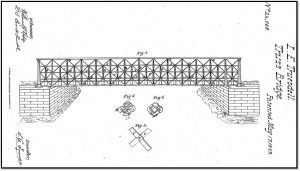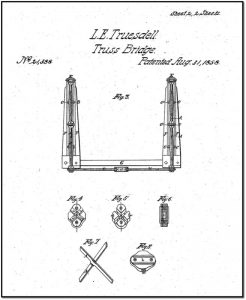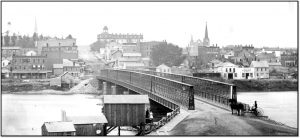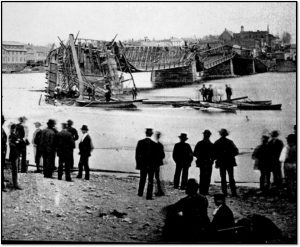Dixon is located about 97 miles west of Chicago on the southwesterly flowing Rock River, a tributary of the Mississippi. A wooden bridge crossed the river at Dixon for years but was frequently washed out in floods. In 1868, it was decided that an iron toll bridge was required, and the Mayor solicited bids. Several committees of the City Council visited bridges and bridge works in Chicago, Detroit, Cleveland, and elsewhere. A total of 11 bridge companies submitted proposals for 45 different bridge styles and lengths from wood to iron. Some of the most well-known firms were John A. Roebling; Smith, Latrobe & Co.; Zeneas King; and L. B. Boomer. The lowest price was $15,000 for a wooden bridge up to $50,000 for an iron bridge. The Dixon City council, after several votes, selected a design by Lucius E. Truesdell for $40 per lineal foot. The Dixon Telegraph wrote that the Council chose Truesdell’s plan, “taking into consideration expense, as well as the form and comeliness of the structure.” Later, it was charged that some of the Council members were bribed, but that charge was never proven. Truesdell had received several patents for bridges and was proposing to build one according to Patent No. 24,068 for a truss bridge, issued on May 17, 1859. It was very similar to patent no. 21,388 issued on August 31, 1858, also for a truss bridge.
Truesdell wrote, “The nature of my invention relates to bridges constructed of iron, and it consists in the use and combination of a double series of horizontal ribs or chords with a series of diagonal and vertical braces or their equivalents, by means of which the strain and tension of the various parts under a rolling weight is in a measure neutralized by the tendency of these parts to distribute them more evenly throughout the whole structure, thereby giving greater strength, rigidity, and firmness to the bridge with less weight of material than is obtained by any other known modes of constructing them.” He also wrote, “These horizontal chords, which are made of wrought or malleable iron and run through the entire length of the bridge, serve the purpose of distributing the tension or strain which may be exerted on any particular portion of the bridge equally throughout the whole, for as the action of a heavy pressure on any part of the structure is to depress it in a vertical plane, and as such a depression can only be effected by an elongation of the baselines of the bridge, thus creating a longitudinal tension and strain, it follows that in a bridge constructed on this plan, as the baseline can not be sensibly elongated without a similar elongation of all the horizontal chords, that any longitudinal tension will be transmitted or distributed through all the horizontal chords; thus relieving that part which lies in the plane of pressure from undue strain.” The truss was a high, 15-foot pony truss in that Truesdale had no overhead cross bracing. He claimed to get his lateral stiffness by having his vertical posts widen out from top to bottom, as shown on his sheet 2 of drawings.
The bridge consisted of five spans (with lengths of 132 feet), a deck width of 18 feet, and two sidewalks with a width of 5 feet each. The total cost of the bridge was $75,000, with $31,512 going to Truesdell for the iron superstructure. The bridge opened on January 21, 1869, to a grand celebration with a local paper writing, “A structure more truly grand and beautiful to the eye can be found in no western city and we presume in no eastern one.” Another paper wrote that the City Council thanked Truesdell, “for the promptness, energy, and faithfulness, and for his gentlemanly courtesy.” Before the opening, the bridge was test loaded in a fashion by placing “four harnessed teams hauling stone, a load of flour, and a large group of bystanders, all weighing at least 45 tons.”
It was later made public that the City Engineer, L. Stanton, had advised against accepting the bridge since the builder did not follow the specifications. He had also been against awarding the bridge to Truesdell, indicating that he “never knew any engineer or practical bridge builder, living or dead, that approved of the plan upon which the Truesdell Bridge was built on,” and it was his opinion that “the City Council who favored the Truesdell bridge were influenced by the opinions of the citizens, rather than by practical bridge builders. Mr. Truesdell was a sharp, shrewd man, who could make a favorable impression upon men; enthusiastic in favor of his own plan and carried the citizens with him.” Stanton was dismissed due to his opposition before completion of the bridge and was not invited to be present when the load testing was made. Later, in the press, he gave many reasons why he opposed the bridge and its construction.
All seemed well, even though a Truesdell bridge in Elgin, Illinois, collapsed on December 7, 1868. And, after being rebuilt, it collapsed again on July 5, 1869. One newspaper deflecting blame from Truesdell wrote, “The foundations of the structure must have been tampered with by some evil-disposed persons,” which was very unlikely.
On May 4, 1873, only four years after its opening, The Dixon Bridge collapsed into the river. On that day, Reverend Pratt, a Baptist minister, was baptizing members of his flock in the river on the north side and west of the bridge, as he had done several times in the past. A large crowd, estimated at 200 people, mainly women and children, gathered on the 5-foot sidewalk. Some young men climbed up on the westerly truss to get a better view. The bridge tender, Henry Strong, was concerned about the number of people bunched together on the sidewalk and was reported to have ordered some off the bridge. After baptizing two members and preparing to baptize the third, people later reported they had heard a cracking of the iron and that the bridge dropped out from under them. The collapse threw bystanders into the water, with the truss falling over onto them and trapping many of them under the ironwork. The end span fell in its entirety in the river, and several other spans dropped partially into the river.
The Chicago Tribune ran almost a full two-page article on the failure, including an engraving of the bridge intact and collapsed. They included such statements as,
“The cause of all this loss of life, and the broken hearts and desolated homes that it entails was the adoption by the city authorities of a bridge of unsound construction built in defiance of the true principles of engineering…”
“The murderous instrument – The bridge which was the cause of this accident – was built in 1868 at a cost of $83,000…the people were rather pleased with it at first, just as a child is tickled with a new toy. It was neat, light, and airy, very becoming to the river –a sort of fashionable, stylish bridge that looked very well but wore very badly.”
“It was very top-heavy. The heavy trusses were too much for the rather light foundation.”
“That these bridges are perilous to life is the opinion of the best engineers. The following relative to the diabolical Truesdell plan shows in what estimation it is held by those competent to judge.”
The reporter interviewed several Chicago Engineers who told him:
“While the bridge was built pretty and light, and to the eye was light and charming, it was practically useless…”
“Mr. Truesdell is no engineer at all. His methods of construction showed an ignorance of the fundamental principles of mechanics, and had always been regarded as worthless by those whose opinion was regarded as valuable.”
“It is not a bridge at all. His method of construction is utterly at fault. The bridge is not worth that, snapping his fingers.”
Mr. Herman said the bridge was constructed on a wrong principle. “The iron was spread over too much ground, and the bracing was very defective. There were five chords in the Truesdell bridge, the middle ones being perfectly useless, simply superfluous, while the other inside ones were not much better.”
The Tribune also reported, “Some sank to rise no more. Some were killed before they touched the water. Some were entangled in the debris. Some jumped from the bridge to the river and swam ashore. The weak generally succumbed.” The truss “fell over with the weight and imprisoned the doomed in an iron cage, with which they sunk and from which there was no escape.” Despite heroic actions by many bystanders to save them, 46 people, 37 of whom were women, lost their lives on that fateful day.
As with any failure, people wanted to know who was to blame for the collapse. Some blamed the City Council while some stated that Truesdell had gotten the project by bribing the councilors. A Coroner’s Jury was set up on May 7 to determine the cause of the failure. They obtained testimony from many locals, all of whom expressed their long-time concern about the safety of the bridge with one saying, “the bridge was a humbug, it was not strong enough to hold itself up,” and another saying, “unequal distribution of heavy weight threw (the bridge) out of perpendicular and let it down,” which was undoubtedly true. A newspaper concluded that Truesdell, “had the means to push his invention, and was thwarted only in the presence of men of science, who again and again declared it dangerous and useless. Every railroad company rejected it on sight.” The Coroner’s Jury concluded, amongst other things, “the council erred in judgment in selecting the Truesdell Bridge.”
The Scientific American wrote, in part:
“From the information gleaned regarding the superstructure, there is little question but that its theory of construction was wrong and the material poor and clearly inadequate. The principle of the Truesdell patent, upon which it was based, is to lock joint all supports… The metalwork throughout the whole fabric was exceptionally frail…But when the facts are on record, not only of the falling of a structure (its counterpart) but of the pronounced opinions of experts that this very fabric was unsafe, the fault must be plainly attributed to neglect…Too much light and cast iron is employed, and the lock joint arrangement so weakens the metal that its full strength cannot be gained…Here was a structure which any competent engineer should have been able to perceive at a glance was improperly built and unsafe, even were he not aware of the experience of others with its defects. Yet we are told that a city council examined it and were suspicious of its strength, and still it was allowed to remain.”
Charles Macdonald, a leading bridge engineer, wrote a letter to the editor of the Dixon Sun, stating in part:
“I have been favored with the perusal of your very enterprising paper containing a list of the bids received for the construction of a bridge at Dixon to replace the one unhappily the cause of such widespread grief in your midst, and having previously read with deep interest your account of that disaster. I am induced to make a few suggestions to the people of Dixon through your columns as to the problem they have to solve in building the new bridge…
First then, you employ a thoroughly competent engineer; you will tell him in general terms what kind of a bridge you require and then give him full power to draw up detailed specifications, in order that all proposals may be compared by one standard. After the bids have been carefully examined, you will require from him a report upon their different merits with especial reasons for any preference he may have for a particular design. And then, as businessmen, you will be in a position to decide as to who shall build your bridge…
With a selection made in such a way, there will be satisfaction in preparing plans and estimates for the new bridge at Dixon, and the people will stand a chance of getting full value for their investment.”
Truesdell wrote a letter to the Springfield Republican on May 22, 1873, and a condensed version was picked up by the New York Tribune, stating, “I know that I never made a better bridge than the one at Dixon in every particular. After the completion of the bridge, a trial of its strength was made, when each span was loaded with teams and people all weighing at least 200,000 pounds…The bridge would have sustained a weight of 250,000 pounds with safety, and yet it is said to have fallen with less than 15,000 pounds. If some of the bolts had been loosened in the top chord near their connections and weights placed on the catwalk, then the bridge would have fallen precisely as it is said to have fallen; and I cannot conceive of any other cause.” He concluded his defense, saying, “It is nearly 18 years since I began building iron bridges and the Elgin and Dixon bridges are the only ones that have fallen, and no loss of life except at Dixon. Can as much be said of any other plan?” The answer to his rhetorical question was yes, and most, if not all of, the engineers of the time agreed the Truesdell Bridge was a poorly designed structure.
The ASCE, at its 5th Annual Convention in Louisville, KY, held only three weeks after the disaster, Resolved, “in view of the late calamitous disaster of the falling of the bridge at Dixon, IL, and other casualties of a similar character…that a committee be appointed to report at the next Annual Convention the most practicable means of averting such accidents.” The committee was a four-star committee consisting of 11 of the leading engineers of their time. Unfortunately, it was not a unanimous solution. Different members of the committee submitted four reports. James Eads and C. Shaler Smith concluded, in part, two years later, “After a careful examination into the causes of the most disastrous accidents which have occurred during the past few years, it finds that they can readily be divided into three different classes. First, where bridges are erected by incompetent or corrupt builders, and accepted by incompetent or corrupt railway or municipal officials…”
The failure of the Dixon bridges can be traced back to its poor design and use of iron. While men like Squire Whipple had designed bridges by forcing the loads to pass through as few members as possible, Truesdell had added members. His truss was not analyzable by any means then known to the profession and, instead, was a “rule of thumb” design. The loading at failure was similar to the Albion Bridge disaster (STRUCTURE, March 2020) when one sidewalk and side of the bridge was loaded with people to view a tightrope walker.■




